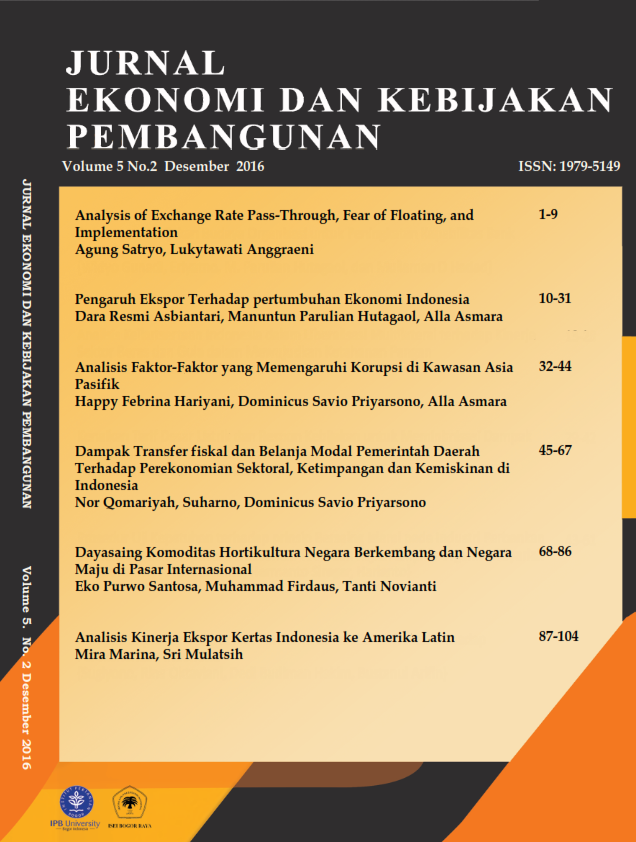DAYASAING KOMODITAS HORTIKULTURA NEGARA BERKEMBANG DAN NEGARA MAJU DI PASAR INTERNASIONAL
Abstract
Horticulture is one of the agricultural sub-sector consisting of vegetables, fruits, biofarmaka mplants (medicinal plants) and floriculture (ornamentals) became one of the commodities subject of international trade, which the demand is increasing in line with increasing household income and growth population. During the period 2005-2014, the average growth value of horticultural exports of developing countries amounted to 69,81 percent higher than the average growth of exports in developed countries as big as 40,78 percent. The global trading of horticulture is faced with price volatility and trade barriers problems. In addition, the increasing demand of these commodities also in line with the increase in household incomes and population growth. Therefore, this study aimed to analyze the competitiveness of horticulture commodities in the international market and the factors that influence trade flow. The results of Export Product Dynamic (EPD) show that there are two horticultural export commodity that has dynamic market position in world market, there are bananas (HS.080300) and pineapples (HS.080430). Generally, the panel data analysis results show that prices, trade barriers, population, real GDP per capita, economic distances, and real exchange rates significantly affect export volumes.
Keywords: Competitiveness, Exports, Horticulture, Gravity model
References
Balassa, B. 1989. Comparative Advantage, Trade Policy and Economic Development, Harvester Wheatsheaf, New York. Bhattacharya KS,
Bhattacharyay BN. 2007. Gains and Losses of IndiaChina Trade Cooperation – A Gravity Model Impact Analysis.CESIFO Working Paper No. 1970.
Crivelli P, Groschl J. 2012. The Impact of Sanitary and Phytosanitary Measures on Market Entry and Trade Flows. Geneva: Universite de Geneve.
[COMTRADE] Commodity Trade Statistics Database. 2015. Acces From World.
Dahar D. 2014. Analisis Dampak Kebijakan Non Tarif Terhadap Kinerja Ekspor Hortikultura Indonesia ke Negara- negara ASEAN +3. Bogor: Institut Pertanian Bogor.
Estherhuizen, D. 2006. Measuring and Analyzing Competitiveness in the Agribusiness Sector: Methodological and Analytical Framework. University of Pretoria.
[FAO] Food and Agriculture Organization..]. Tersedia pada : http://faostat3.fao.org/download/Q /QC/E. [April 2015]
Ferro E, Otsuki T and Wilson J. 2015. The effect of product standards on agricultural exports. Food Policy 50 (2015) 68-79. Published by Elsevier Ltd.
Haryadi. 2008. Dampak Liberalisasi Perdagangan Pertanian Terhadap Perekonomian Negara Maju dan Berkembang. Institut Pertanian Bogor. Bogor.
Ginting, AM. 2013. Pengaruh Nilai Tukar terhadap Ekspor Indonesia. Buletin Ilmiah Litbang Perdagangan. 7 (1): 1-18. Jakarta: Kementerian Perdagangan.
Krugman PR, Obstfeld M, Melitz. 2012. International Economics, Theoryand Policy, Ninth Edition. NJ (US) : Addison-Wesley Publising Company.
Mankiw, N.G.2003. Teori Makroekonomi edisi kelima. Jakarta: Erlangga.
Mergenthaler, M, Weinberger, K & Qaim, K. 2009. The Food System Transformation in Developing Countries: A Disaggregate Demand Analysis for Fruits and Vegetables in Vietnam. Food Policy 34(5): 426-36.
Miet M, Johan S. 2014. Agricultural Trade And Development: A Value Chain Perspective. WTO Working Paper ERSD-2015-04.
Saptana A. Agustian, H. Mayrowani, dan Sunarsih. 2006. Analisis Kelembagaan Kemitraan Rantai Pasok Komoditas Hortikultura. Pusat Analisis Sosial Ekonomi dan Kebijakan Pertanian. Badan Penelitian dan Pengembangan Pertanian. Departemen Pertanian.
[WDI] World Development Indicators. [Internet]. [Diunduh Januari 2015]. Tersedia pada: http://data.worldbank.org/datacatalog/world-developmentindicators.
Wei G, Huang J dan Yang J. 2012a. The Impact of Food Safety Standard on China’s Tea Export. China Economic Review 23 (2012) 253- 264.
.2012b. Honey Safety Standard and Its Impact on China’s Honey Export. Journal of Integrative Agriculture : 11(4) : 684-693.
World Bank. 2008. World Development Report 2008: Agriculture for Development. World Bank. Washington D.
Authors

This work is licensed under a Creative Commons Attribution-NonCommercial-ShareAlike 4.0 International License.
The authors who publis article(s) in Jurnal Ekonomi and Kebijakan Pembangunan have to understand and agree that the copyright of article published is owned by Jurnal ekonomi and Kebijakan pembangunan including to reproduce, distribute and sell this journal to public.

